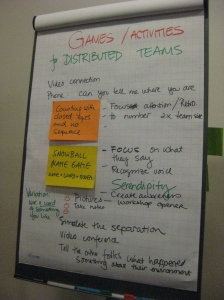While Agile and Scrum philosophies were formulated within software development context, these have been applied in many other areas. Examples:
- Humanitarian aid and emergency response: InSTEDD – Innovative Support to Emergencies, Diseases and Disasters (55 min video) e.g. responding to the Haiti Earthquake and other humanitarian projects
- Managing Volunteers, by Dan Mezick (Sep 2010), managing world-wide volunteers to establish an Agile Community of Practice with Project Management Institute (PMI)
- Scrum in Church Ministry – by James Higginbotham – volunteer recruiting and management, project management and leadership in church ministry
- Scrum in Church by Arline and Jeff Sutherland (2009), break down silos, encourage communication, collaboration, transparency, drive higher velocity and quality
- Scrum in Venture Capital – OpenView Venture Partners (investors in VersionOne) by Jeff Sutherland (2010), significanlty increased project results, quality issues resolved before impacting customers
- Scrum in Sales at AccuRev (Sep 2010)
- Scrum in Marketing , by Andrew Filev (Nov 2007), also by Ben Bradley (Oct 2005) – increments reduce risk
- Lonely Planet travel guides – by Nigel Dalton (Oct 2009), and the adoption process, with cross-functional teams (writers, graphic artists, desktop publishing, marketing, editors etc), and a sprinkle of “watergile”, incrementally developed the book chapter by chapter with Scrum, significantly reduced hand-off delays.
- Translation Project – Daniel Teng, 2010, kanban approach to translating “User Stories Applied” book to Chinese; good example of evolution of “definition of done” and results of applying corrective measures
- Nursing: Lean methods to improve Operating-Room Turnover Time – at at Parkridge Medical Center, Chattanooga, Tenn (Nov 2006), Improve Patient Flow using Six Sigma (July 2007)
- Hospital Management – ThedaCare, Wisconsin: increasing efficiency avoided hospital layoffs (Oct 2010); The Healthcare Relay Race (Nov 2010)
- Hospital Efficiency Metrics – Minimize errors and waste, Optimize performance, patient outcome and profitability (Jun 2009)
- Nursing: The Art of Implementing Lean (Oct 2010) – improve patient experience and reduce cost
- Scrum in Process Improvement – by Sameh Zeid (March 2010) at Orlando Scrum Gathering
- Military: Agile Combat Support (2003), in US military logistics etc.
- At home and with family: Iterating with Children by David Starr, Saturday chores picture by Alan Dayley – plus how to do it, Organizing a Barbecue by Henrik Kniberg (Jul 2008) , Scrum for Kids by Peter Stevens (Sep 2010), Scrum and Bathroom by Peter Stevens (Mar 2009)
See more articles “Scrum is not just for Software” on the ScrumAlliance site.
One concept all the above examples have in common: the desire to create a “learning organization”, to improve the present practice for a better future – regardless of the specific definition of “better”.



Recent Comments